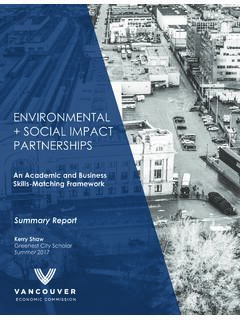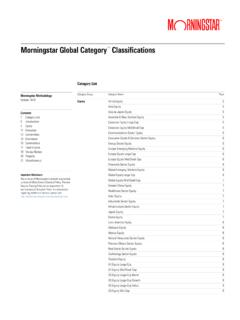Transcription of Life Cycle Analysis of Electric Vehicles
1 Life Cycle Analysis of Electric Vehicles Quantifying the Impact Prepared by: Balpreet Kukreja, UBC Sustainability Scholar, 2018 Prepared for: Adrian Cheng, Equipment Services, City of Vancouver August 2018 ii Acknowledgements The author would like to thank the following individuals for their contribution, feedback, and support throughout this project. Adrian Cheng, Equipment Services, City of Vancouver Evan Dacey, Equipment Services, City of Vancouver iii Table of Contents Executive Summary _____ 1 Introduction _____ 2 Why Life Cycle Analysis ? _____ 2 Goal _____ 3 Scope _____ 3 Methodology _____ 4 Data Sourcing _____ 4 Life Cycle Inventory _____ 5 Raw Material Production _____ 6 Manufacturing _____ 7 Transportation _____ 8 Operation _____ 9 Decommissioning _____ 9 Summary _____ 10 Comparison of Results with Similar Analysis _____ 11 Sensitivity Analysis _____ 12 Future Use of Lithium-Ion Batteries _____ 15 Conclusion _____ 16 References _____ 17 Life Cycle Analysis of Electric Vehicles | Balpreet Kukreja 1 Executive Summary The City of Vancouver has an extensive fleet of Vehicles .
2 Due to the significant impact of transportation on total greenhouse gas emissions from a region, the City wants to reduce this impact by replacing more internal combustion engine Vehicles (ICEVs) in its fleet with Electric Vehicles (EVs). This study uses life Cycle Analysis (LCA) to comparatively analyze two vehicle models of similar size of each type (ICEV and EV) currently used in the City s fleet. Ford Focus is chosen for the ICEV and Mitsubishi i-MiEV for the EV, both with a vehicle life of 150,000km. Carbon emissions and energy consumption are analyzed for each phase from cradle-to-grave for both Vehicles : raw material production, vehicle manufacture, transportation, operation, and decommissioning. The Analysis shows that the Electric vehicle has notably lower carbon emissions and lower energy consumption per kilometer. After considering all phases, the Ford Focus emits and Mitsubishi i-MiEV emits over the vehicle life.
3 Corresponding energy consumption is for Ford Focus and for Mitsubishi i-MiEV. Sensitivity Analysis with a vehicle life of 100,000km and 250,000km is also conducted, with the longer vehicle life further shifting the efficiency balance toward the Electric vehicle. Life Cycle Analysis of Electric Vehicles | Balpreet Kukreja 2 Introduction Electric powertrains are a promising technology for the propulsion of Vehicles with potential to improve air quality and reduce greenhouse gas emissions associated with road transport. Electric powertrains are more efficient than internal combustion engine Vehicles (ICEVs) and have zero tailpipe emissions (Sadek, 2012). In addition, the technology can help to mitigate the transport sector s heavy reliance on fossil fuels. On the flipside, large scale adoption of Electric Vehicles (EVs) may require additional electricity generation.
4 Electric powertrains also require advanced components with a more diverse resource requirement that may have different environmental impacts to those of a conventional vehicle (Nordel f & Messagie, 2014). This study employs the cradle-to-grave approach of life Cycle Analysis to assess environmental impacts for similar sized gasoline and Electric Vehicles in the City of Vancouver fleet that have been in service for at least 5 years. Why Life Cycle Analysis ? Life Cycle Analysis (LCA) can be utilized to analyze the advantages and disadvantages of a technology (ISO, 2006). In this study, this is done by assessing the environmental impacts, specifically energy use and CO2-equivalent emissions, during each stage of the vehicle s life. When a new vehicle is acquired, there are already significant inflows and outflows associated with it. The inflows to a system can include water use, natural resources and energy input, while the outflows can include emissions and waste products.
5 While average mileage or tailpipe emissions allow us to compare the efficiency of different Vehicles , it provides an incomplete picture as this is only comparing flows associated with operation of the vehicle; none of the flows associated with stages prior to vehicle operation have been considered. This data is relevant to decision makers within the City of Vancouver and could be used for strategic planning within the Equipment Services division of the City for potential future electrification of vehicle fleets. Life Cycle Analysis of Electric Vehicles | Balpreet Kukreja 3 Goal The goal of this study is to analyze environmental impacts, specifically energy use and CO2-equivalent emissions, and quantify data based on a functional unit for two vehicle types of similar size: Ford Focus and Mitsubishi i-MiEV. This data is collected for the resource extraction, manufacturing, transportation, operation, and decommissioning stages of the vehicle.
6 Options are also presented for future use of retired vehicle components such as the lithium-ion battery. Scope The scope of this study is to analyze 13 Ford Focus internal combustion engine Vehicles put in service in 2006 or later and 27 Mitsubishi i-MiEV Electric Vehicles put in service in 2012 or later in the City of Vancouver fleet. These Vehicles are comparatively analyzed due to their similar size. This Analysis encompasses the equipment life Cycle of the Vehicles and is focused on scope 1 emissions, as shown in Figure 1. The well-to-wheels lifecycle of energy production (scopes 2 and 3) falls outside of the scope of this study and is considered under the BC Low Carbon Fuel Standard. Figure 1 System boundaries for a complete life Cycle Analysis of Vehicles . This study focuses on the equipment life Cycle and does not analyze the well-to-wheels life Cycle .
7 (Nordel f & Messagie, 2014) Life Cycle Analysis of Electric Vehicles | Balpreet Kukreja 4 Methodology A functional unit of one kilometer (1 km) travelled by a vehicle is used throughout the study. This functional unit is then adapted for the different analyses energy consumption is presented as MJ/km and emissions as gCO2-eq/km, assuming an average vehicle life of 150,000km for both Vehicles . Data is gathered for inflows and outflows at each stage. The processes are linked from cradle-to-grave and an inventory is taken for the flows to show how they connect and affect each other. Finally, sensitivity Analysis is completed for cases where vehicle lifetime is 100,000km and 250,000km. Data Sourcing Data for raw materials used in both Electric and gasoline Vehicles was obtained from Weiss et al. (2000), a study that breaks down total materials by element for both vehicle types.
8 While the dataset is based on predictions made in the early 2000 s, it is a robust study that is still relevant today. (Weiss & Heywood, 2000) Data for vehicle manufacture was estimated as a linear function of material mass due to the highly complex supply chain in the automobile industry. The Ford Focus is assumed to be assembled in Wayne, Michigan and is transported by a combination of rail and truck with a gross vehicle weight of 1355kg (Ford Motor Company, 2018). The Mitsubishi i-MiEV is assumed to be assembled in Kurashiki, Japan and is transported by sea with a gross vehicle weight of 1450kg (Mitsubishi Motors, 2018). Operational data for fuel consumption and maintenance is sourced from the City of Vancouver databases for gasoline Vehicles . Electric vehicle charging stations are manufactured by ChargePoint and access to their online dashboard provides data on electricity consumed for EVs operated by the City.
9 Finally, the end of life procedures assume that a vehicle is dismantled and all parts except for the lithium-ion batteries are shredded. Options for future use of the lithium-ion batteries are presented later in the report. Life Cycle Analysis of Electric Vehicles | Balpreet Kukreja 5 Life Cycle Inventory Energy requirements and emissions from vehicle material production are presented in the following sections. Figures 2 and 3 show the mass distribution by material for both ICEV and EV. Ferrous metals (mainly high-strength steel) are a large percentage of material used in ICEVs while both steel and aluminum are significant components of an EV. Figure 2 Mass distribution of an internal combustion engine vehicle. Various alloys of steel account for two thirds (67%) of vehicle mass, with aluminum and plastics having the largest mass for non-steel materials (Weiss & Heywood, 2000).
10 886810910064543510957105485 Internal combustion engine vehicle mass distribution by material (kilograms)Ferrous MetalsAluminumNickelOthersPlasticsWood, Felt, , coatingsZincLeadFluidsLife Cycle Analysis of Electric Vehicles | Balpreet Kukreja 6 Figure 3 The predicted mass distribution of an Electric vehicle in 2020 shows a different picture, with aluminum and nickel having a much more significant role. Ferrous metals (mainly high-strength steel) are still the dominant material. (Weiss & Heywood, 2000) Raw Material Production The production to convert raw material to a virgin input for manufacturing is analyzed based on data from Sullivan et al. (2010) and is summarized in Figure 4. This energy intensity data was then applied to the data shown in Figure 2 and Figure 3. This gave total energy consumed in material production as for the Ford Focus and for the Mitsubishi i-MiEV, or and Carbon intensity of this stage was calculated from emission factors at the respective manufacturing locations.






